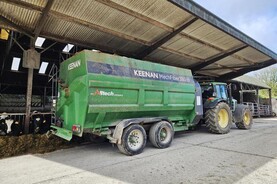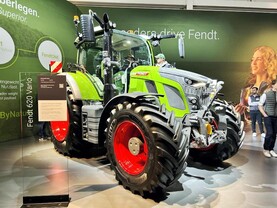Most of us who grew up with tractors of the 1970s still have fond memories of our early work experiences with these tractors. So much so that those not normally prone to sentimentality, myself included, get a different feeling when you locate a tractor that meant something special to you at a particular time of your youth.

That special day when I came to collect the John Deere 1020 from Tony Harty in Kiltulla, Co Galway, a tractor that had meant so much to me.
Finding the 1967-built John Deere 1020 from my college working days was indeed something special for me. It coincided with a prominent birthday; not that I needed an excuse to bring back that particular tractor to its former glory, but let’s just say that it helped.
This little John Deere was very special. It was probably one of the few 20 Series John Deere tractors working in Galway for a period of 15 years. The tractor was bought in the 1960s by the late Paddy “Bushy” Moloney, a Gort, Co Galway-based contractor.

The John Deere 1020 was unique in tractors of its size in having fully hydraulically operated brakes on the rear axle; these were fully seized and are now working again to give good stopping power.
Next to a Ferguson 35, this was the smallest tractor in Paddy Moloney’s fleet, but it was one that everyone seemed to want to drive. It was capable and compact, yet its engine was rated to deliver 39hp on the PTO. It worked at buck-raking silage and small square baling in the summertime and was always on duty for a variety of jobs for the rest of the year.
The three-cylinder engine on this 1966 built Mannheim tractor was sweet to listen to. It gave more than 30 years of reliable service in Moloney’s yard.
Because of its size it was reserved for smaller and lighter jobs. I worked each summer at Moloney’s from 1975 until 1979, the year that I started work at the Irish Farmers Journal. I also worked during the most of the month of April each year, when we had over three weeks off as study leave from UCD during my final two college years.
My study leave was often from the John Deere 1020 tractor seat, mainly at ploughing duties, with a heavy three-furrow Overum plough that tested its stability on the road, but not its pulling power in the field.
After Paddy Moloney passed away, the tractor was bought by Tony Harty from Kiltulla, Co Galway, and it was from Tony’s care that I bought it after a chance meeting. Since then, I have restored the tractor to its former condition, with support from Edgeworthstown-based Michael O’Neill.
The tractor was part of the display at the John Deere celebration event held by Fingal Vintage Society in February of this year. Its first and only public outing so far.
Restoration details
For the restoration process, the John Deere 1020 bodywork required extensive work to restore its original identity, which included upgrading the lighting system.
The time and effort was spent to improve the tractor bodywork, while retaining as much of the original parts as possible. This is job for those with patience, filling and sanding mudguards, the bonnet and other steel panels, before painting with two-pack paint. The engine had already been worked on, so there was little to do mechanically other than replace oils and filters, and free up the seized hydraulic brake system.

The front panel of the tractor has been damaged in an attempt to change the lights, this was filled in and painted to complete obscure the damage of the past.
I sourced some parts for the tractor from John Deere parts specialist, Nick Young in the UK. These included wheel nuts for rear wheels, a logo front medallion , bottom radiator hose, O rings and seal for the brake unit, plugs valve inside, side screen panels for each side with springs, a front oil bath air filter, a set of decals and a nine-hole bar in John Deere green, to start with.

John Deere 1020 front-mounted hydraulic pump was unique at the time in powering a closed-centre hydraulic system.
Nick Young also sourced a replacement exhaust and some other fittings, not all new, but enough to make the restoration authentic.
The tyres on the tractor were Dunlop remoulds from the early 1970s, produced in Dunlop’s Cork tyre factory, now itself a distant memory. These were replaced with similar sized 11-28 from the BKT Agrimax range as were the front tyres, for safety reasons.
The front panel of the tractor has been damaged in an attempt to change the lights, this was filled in and painted to complete obscure the damage of the past.
My overall spend on the tractor came close to €6,000 from its purchase, to parts supplies and restoration. This is a little more than €100 per year for life so far; a fair investment in what is a very special tractor. Now, I just need to find time to enjoy it a little more.
A tractor run to remember
I took the tractor for a run on an early June sunshine morning across the north Longford near Cairn Hill and on into South Leitrim. The engine sound and the smell of the diesel exhaust went through my system, to give me a fix of something of my past.
As I stopped on the roadside near Cairn Hill I surveyed the countryside that spanned the four counties of Leitrim, Longford, Roscommon and Westmeath. It unconsciously brought me back to days that I used the small John Deere as my work transport to get across Co Clare, when cutting hedges. Back then I often stopped coming over Maghera Hill, from Tulla to admire the Burren views. My June tractor run relived those kinds of experiences with warm pleasure.
Most of us who grew up with tractors of the 1970s still have fond memories of our early work experiences with these tractors. So much so that those not normally prone to sentimentality, myself included, get a different feeling when you locate a tractor that meant something special to you at a particular time of your youth.

That special day when I came to collect the John Deere 1020 from Tony Harty in Kiltulla, Co Galway, a tractor that had meant so much to me.
Finding the 1967-built John Deere 1020 from my college working days was indeed something special for me. It coincided with a prominent birthday; not that I needed an excuse to bring back that particular tractor to its former glory, but let’s just say that it helped.
This little John Deere was very special. It was probably one of the few 20 Series John Deere tractors working in Galway for a period of 15 years. The tractor was bought in the 1960s by the late Paddy “Bushy” Moloney, a Gort, Co Galway-based contractor.

The John Deere 1020 was unique in tractors of its size in having fully hydraulically operated brakes on the rear axle; these were fully seized and are now working again to give good stopping power.
Next to a Ferguson 35, this was the smallest tractor in Paddy Moloney’s fleet, but it was one that everyone seemed to want to drive. It was capable and compact, yet its engine was rated to deliver 39hp on the PTO. It worked at buck-raking silage and small square baling in the summertime and was always on duty for a variety of jobs for the rest of the year.
The three-cylinder engine on this 1966 built Mannheim tractor was sweet to listen to. It gave more than 30 years of reliable service in Moloney’s yard.
Because of its size it was reserved for smaller and lighter jobs. I worked each summer at Moloney’s from 1975 until 1979, the year that I started work at the Irish Farmers Journal. I also worked during the most of the month of April each year, when we had over three weeks off as study leave from UCD during my final two college years.
My study leave was often from the John Deere 1020 tractor seat, mainly at ploughing duties, with a heavy three-furrow Overum plough that tested its stability on the road, but not its pulling power in the field.
After Paddy Moloney passed away, the tractor was bought by Tony Harty from Kiltulla, Co Galway, and it was from Tony’s care that I bought it after a chance meeting. Since then, I have restored the tractor to its former condition, with support from Edgeworthstown-based Michael O’Neill.
The tractor was part of the display at the John Deere celebration event held by Fingal Vintage Society in February of this year. Its first and only public outing so far.
Restoration details
For the restoration process, the John Deere 1020 bodywork required extensive work to restore its original identity, which included upgrading the lighting system.
The time and effort was spent to improve the tractor bodywork, while retaining as much of the original parts as possible. This is job for those with patience, filling and sanding mudguards, the bonnet and other steel panels, before painting with two-pack paint. The engine had already been worked on, so there was little to do mechanically other than replace oils and filters, and free up the seized hydraulic brake system.

The front panel of the tractor has been damaged in an attempt to change the lights, this was filled in and painted to complete obscure the damage of the past.
I sourced some parts for the tractor from John Deere parts specialist, Nick Young in the UK. These included wheel nuts for rear wheels, a logo front medallion , bottom radiator hose, O rings and seal for the brake unit, plugs valve inside, side screen panels for each side with springs, a front oil bath air filter, a set of decals and a nine-hole bar in John Deere green, to start with.

John Deere 1020 front-mounted hydraulic pump was unique at the time in powering a closed-centre hydraulic system.
Nick Young also sourced a replacement exhaust and some other fittings, not all new, but enough to make the restoration authentic.
The tyres on the tractor were Dunlop remoulds from the early 1970s, produced in Dunlop’s Cork tyre factory, now itself a distant memory. These were replaced with similar sized 11-28 from the BKT Agrimax range as were the front tyres, for safety reasons.
The front panel of the tractor has been damaged in an attempt to change the lights, this was filled in and painted to complete obscure the damage of the past.
My overall spend on the tractor came close to €6,000 from its purchase, to parts supplies and restoration. This is a little more than €100 per year for life so far; a fair investment in what is a very special tractor. Now, I just need to find time to enjoy it a little more.
A tractor run to remember
I took the tractor for a run on an early June sunshine morning across the north Longford near Cairn Hill and on into South Leitrim. The engine sound and the smell of the diesel exhaust went through my system, to give me a fix of something of my past.
As I stopped on the roadside near Cairn Hill I surveyed the countryside that spanned the four counties of Leitrim, Longford, Roscommon and Westmeath. It unconsciously brought me back to days that I used the small John Deere as my work transport to get across Co Clare, when cutting hedges. Back then I often stopped coming over Maghera Hill, from Tulla to admire the Burren views. My June tractor run relived those kinds of experiences with warm pleasure.











 This is a subscriber-only article
This is a subscriber-only article










SHARING OPTIONS: